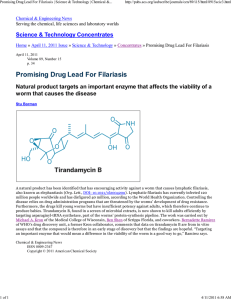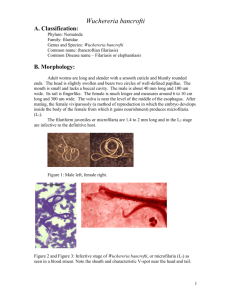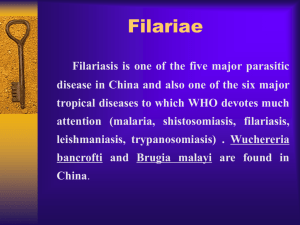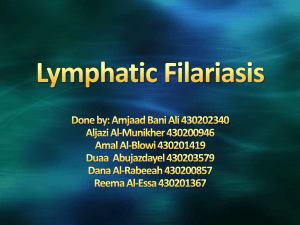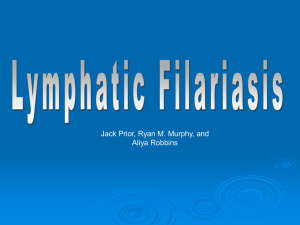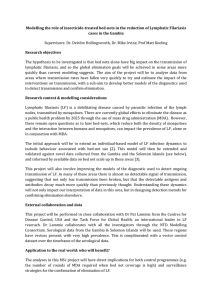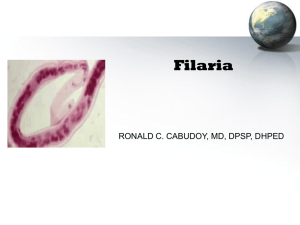Lymphatic Filariasis Report
advertisement
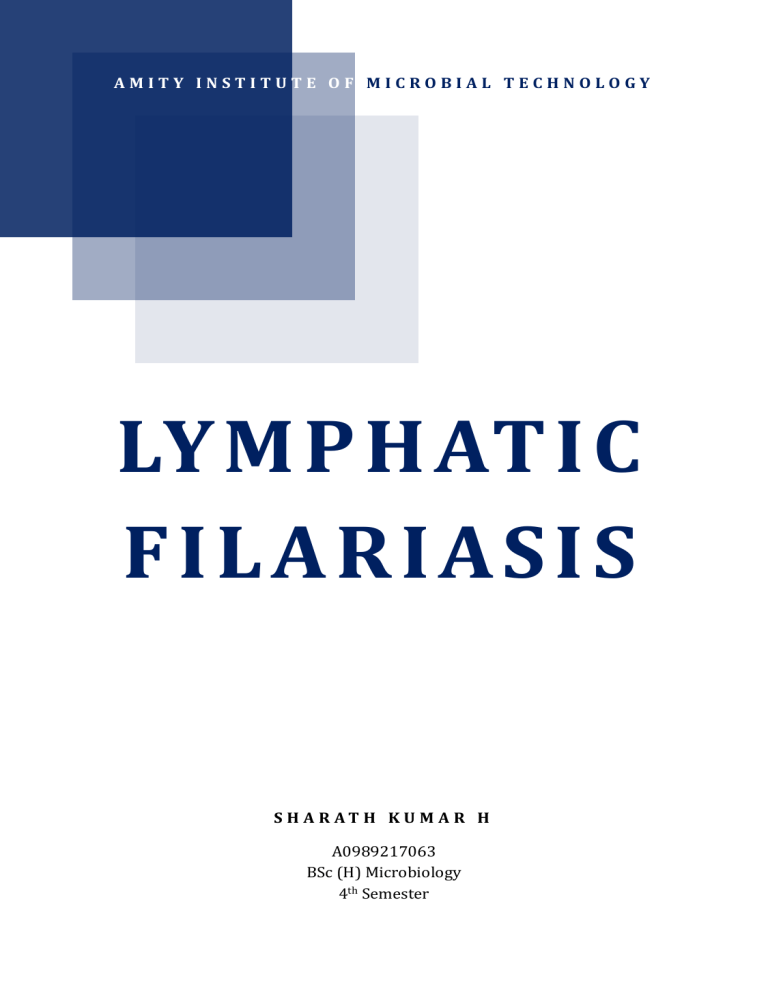
AMITY INSTITUTE OF MICROBIAL TECHNOLOGY LYMPHATIC FILARIASIS S H A R AT H K U M A R H A0989217063 BSc (H) Microbiology 4th Semester Glossary Abscess: localized collection of pus surrounded by inflamed tissue Acute Attack: acute onset of fever with localized pain and warmth, with or without swelling or redness, in a limb or genital area; also used as a synonym for acute dermat Olymphangioadenitis Adenopathy: any disease or enlargement of a lymph gland. Acute Filarial Lymphangitis: inflammation caused by the death of adult worms, which usually produces a palpable ‘cord’ along the lymph vessel and progresses distally Antifilarial Medicine: medicines used to kill filarial parasites; most primarily decrease microfilaria in the blood and may or may not kill adult worms in lymphatic vessels Antifungal Cream: a cream that kills fungi or stops them from growing; used to treat entry lesions between the toes. For patients with advanced-stage lymphoedema (elephantiasis), antifungal creams can help prevent fungal infections in deep folds and in the interdigital spaces. chronic manifestation: clinical sign present over a long period Chyluria: presence of chyle in the urine as a result of organic disease (as of the kidney) or obstruction of lymph flow from ruptured lymph vessel Haematuria: blood in urine Hydrocoele: collection of excess fluid inside the scrotal sac that causes the scrotum to swell or enlarge. Lymphatic System: network of nodes and vessels that maintain the delicate balance of fluid between the tissues and blood; an essential component of the body’s immune defence system Lymphoedema: swelling caused by the collection of fluid in tissue Microfilaria: microscopic larval stage of filarial parasites that circulate in the blood and are transmitted by mosquitoes Microfilaraemia: presence of microfilariae in blood 1 Introduction Lymphatic filariasis is a vector-borne parasitic disease that is endemic in many tropical and subtropical countries. The disorder is due to thread-like, parasitic filarial worms: Wuchereria bancrofti, Brugia malayi or B. Timori belong to Class: Chromadorea, Order: Spirurida, Super Family: Filarioidea and Family: Onchocercidae. W. Bancrofti is maximum extensively unfold and is liable for greater than 90% of the infections B. Malayi is discovered in several Asian countries, whereas B. Timori is handiest discovered in Indonesia. Many specific mosquito species can act as vector for transmission of lymphatic filariasis. The parasites are transmitted by mosquitoes and their existence cycles in humans consist of adult worms living in the afferent lymphatic vessels while their younger ones, the microfilariae, flow into in the peripheral blood. Although clinically asymptomatic, lymphatic filariasis also can be associated with lymphatic ailment, that's accountable for sizeable suffering, deformity and incapacity. Bancroftian filariasis, due to Wuchereria bancrofti is accountable for 90% of those with lymphatic filariasis and the others are because of Brugian parasites. Lymphatic filariasis is a global health problem. At the existing time, the World Health Organization (WHO) anticipated that over 1.25 billion people are at risk in 72 countries and territories. It is understood that approximately one hundred twenty million people inflamed with lymphatic filariasis and over 40 million have pathologic outcomes, which includes the disfiguring elephantiasis. Clinical sickness is manifested mainly as acute adenolymphangitis and continual lymphedema that could result in elephantiasis in men and women and to the formation of hydroceles (enlargement of the external genitalia) (for W. Bancrofti at least) in men. Lymphatic filariasis has been regarded to arise within the Nile region of Africa. Ancient monuments advocate that the sickness may additionally had been gift as early as 2000BC. The proof from Indian origin about the disorder was the outline of signs and symptoms and signs of filariasis in “Madhava Nidhan” in 7th Century A.D. 2 done by Madhava Karan. Artifacts from the Nok civilization in West Africa may additionally display scrotal swelling, another characteristic of elephantiasis. The first written account of lymphatic filariasis comes from the ancient Greek and Roman civilizations. In these civilizations, writers had been even able to distinguish between the similar signs and symptoms of leprosy and lymphatic filariasis, describing leprosy as "elephantiasis graecorum" and lymphatic filariasis as "elephantiasis arabum." 3 Causative Agents Wuchereria bancrofti Bancrofti is the most well-documented and massive reason of lymphatic filariasis. It is more common to discover elephantiasis in patients affected with W. Bancrofti than the ones affected with the Brugian filariasis, despite the fact that it may occur. Bancroftian filariasis normally consists of signs related to the genitalia or chyluria in heavily infected sufferers. W. Bancrofti is transmitted specifically by using Anopheles and hence microfilaria of W. Bancrofti is discovered at excessive ranges at night time. Additionally, W. Bancrofti has no documented animal reservoir besides humans. The microfilariae/mf or larval stage of W. Bancrofti, are enclosed, and variety from approximately 245 to 300μm. Nuclei do not seem to appear at the tip of the tail, which is a major difference from the different mf. It can take quite a few months for the mf to sexually mature, and in the adult stage they could stay for numerous years. As adults, the males variety from 2.5-4 cm, and the females from 5-10 cm. One end of the spherical form is blunt, while the opposite is pointed. Both Bancroftian and Brugian filariae lack a digestive tool, instead absorbing nutrients from their hosts. The causative organism of filariasis changed into microfilaria and it was found by Demanquay in 1863 in the hydrocoelic fluid of man. In 1876 Bancroft observed the adult female worm in man. The adult male changed into first seen through Bourne (1888). In 1878 Manson said that a mosquito of the genus Culex acts because the transmitting agent for Wuchereria bancrofti. He (1887) also studied the existence history of this parasite and recommended reasons for the marked diurnal periodicity of microfilaria in the peripheral human flow. Vogel and Fain gave accounts of the adult structure in 1928 and 1951 respectively. 4 (b) (a) Anterior part of female Wuchereria bancrofti (a) Adult worms of Wuchereria bancrofti (a) Microfilariae ► The stay and active microfilariae are colourless, translucent and have elongated bodies with blunt heads and somewhat pointed tails. ► The microfilariae of W. Bancrofti measures approximately 290 μm in length and 6-7 μm in breadth. ► The live microfilariae are surrounded in a thin covering which projects highly past both the ends of the larvae. ► The sheath or covering is much longer than the larval body in order that the larva can flow back and forth inside it. The sheath is present as a making an investing membrane round the larva and it signifies the chorionic envelope. ► The cuticle is thin and striated and is secreted by using a solo layer of sub-cuticular cells. ► The anterior end of mf. Bancrofti is blunt bearing a separate cephalic space and rudiments of mature buccal cavity with oral stylet ► The larva is pointed at the posterior end. 5 Microfilariae of W. bancrofti. Brugia malayi The distribution of B. Malayi may be very similar to that of W. Bancrofti. However, instances are focused in Asia, along with South China, India, Indonesia, Thailand, Vietnam, Malaysia, the Philippines, and South Korea. Brugian filariasis does now not encompass symptoms related to the genitalia or chyluria. B. Malayi is transmitted with the aid of Mansonia mosquitoes. Since these mosquitoes feed basically in the course of the day, B. Malayi microfilariae can be found inside the blood at some point of the day. B. Malayi has been discovered in Macaques, leaf monkeys, cats and civet cats. The morphology is similar to W. Bancrofti. Generally, microfilariae variety from 200275 μm and mature female worms common approximately 3.5-6 cm long while male are around 1.5-2.1 cm. Microfilariae of B. Malayi are enclosed like W. Bancrofti, and have a totally comparable form. However, the nuclei enlarges nearly to the tip of the tail, a feature that is not shared with W. Bancrofti. 6 Brugia malayi B. timori B. Timori is less common and consequently least studied species of filaria identified to cause lymphatic filariasis. This species was reported at the Island of Timor in 1964, and has on the grounds that been determined in different islands in Indonesia. In regards to vectors, periodicity and reservoirs, B. Timori is extra just like W. Bancrofti than to B. Malayi. Transmission of B. Timori is by way of the Anopheles barbirostris, a vector that feeds at night. As a result, excessive stages of B. Timori mf are observed inside the blood at night. B. Timori also has no recognized animal reservoir. In regards to signs and morphology, B. Timori resembles B. Malayi extra than W. Bancrofti. Like B. Malayi, signs and symptoms related to B. Timori are just like W. Bancrofti, with elephantiasis handiest expressed in the lower part of the limbs. Mf of both B. Timori and B. Malayi has nuclei that amplify to the tip of the tail. However, at about 310 μm, microfilaria of B. Timori is slightly large than that of B. Malayi. 7 Development of Disease The pre-patent period (biological incubation period) It is the time between access of contamination stage larvae to the improvement of mature worms and appearance of mf within the circulating blood of the host. It has been predicted to require a year or extra. However, the B. Malayi takes 3 – 4 months to expand within the definitive host. The patent (symptom-less) period This degree is characterized via the presence of mf within the peripheral blood however without any scientific manifestations of filariasis. This is the maximum essential group that serves as the secondary service of contamination. An enormous percentage of population stay microfilaraemic (presence of mf in blood) and asymptomatic for years together and in some cases for entire life. However a few individuals come to be amicrofilaraemic while other may additionally progress more swiftly to the acute and chronic stages. Most of the asymptomatic instances have lymphatic aberrations as detected with the aid of lymphoscintigraphy and also renal anomalies, which is evidenced through hematuria and/or proteinuria. The acute or allergic stage The acute medical manifestations of filariasis are characterized by episodic attacks of adenolymphangitis (ADL) with constitutional signs and symptoms like fever, chills, malaise, nausea, headache and vomiting. In bancroftian filariasis the ADL attacks occur generally in the limbs and groin while the male genitalia are the most usually affected at some stage in the extreme degree, leading to funiculitis, epididymitis or orchitis. The repeated attacks of ADL precede the development of persistent lymphatic pathology of filariasis and these often preserve for many years. ADL lasts usually for 3 - 5 days but occasionally may stay up to 15 days. Lymphoedema 8 Lymphoedema is regularly gift all through the episodes and usually subsides after acute stage. However from time to time it does not subside and cause chronic adjustments The chronic manifestations The most noticeable function of scientific signs brought on as a result of filarial contamination is referred to within the chronic level. This happens due to blockage of lymphatics. The primary persistent signs are hydrocoele, chyluria, lymphoedema and elephantiasis, which may additionally fluctuate in incidence from one area to any other. More extreme are the blockage of the stomach or thoracic lymph vessels, which sooner or later cause chyluria or hematochyluria. This degree is regularly incurable. 9 Life Cycle All human filarial nematodes have a complex lifestyles cycle related to an insect vector, with Wuchereria and Brugia being transmitted by means of mosquitoes. Infection starts with the deposition of infective larvae (L3) within the skin for the duration of a mosquito bite. The larvae then move in via the puncture wound, reaches the lymphatic system and travel towards the lymph nodes. They live inside the lymphatics and lymph nodes and undergo a procedure of molting and improvement to shape L4 larvae and then mature or adult worms. Following mating the mature female releases live offsprings called microfilariae that flow in the bloodstream. These microfilariae can then be ingested via a mosquito at some point of a subsequent blood meal, in which in they go through improvement to shape L2 and in the end L3 larvae. The complex life cycle causes a complex host immune response, and it is this complication of the host-parasite interaction this is thought to cause the varied clinical manifestations of lymphatic filariasis. Lymphatic filariasis can show up itself in a ramification of clinical and subclinical situations. The most common scientific manifestation is a extremely asymptomatic or subclinical contamination characterised by using the presence of circulating microfilariae and the relative absence of scientific signs and symptoms. 10 Life Cycle of a filarial worm causing the Lymphatic Filariasis 11 Treatment and control Palliative Treatment Pathological signs and symptoms may be treated at an early grade. There isn't any drug that may reduce ugly swelling. Report is available that DEC with Coumarin can reduce pathological swelling upto some quantity. Repeated cleaning of the affected portion with cleaning soap and water and alertness of antibiotic-antifungal creams have dramatic impact at the elephantoid limbs. Raising the affected limb and excising limb to promote lymph flow. Keeping nail clean and put on footwear. Using local antiseptic or antibiotic lotions to treat small wounds or abrasions are the Palliative treatment. Asymptomatic should be treated to forestall aggravation of the disorder signs and symptoms as they've hidden lymphatic damages. Other symptoms like TPE, chyluria are dealt with with DEC as no other drug is available. Finally surgical remedy wanted. Diethylcarbamazine (DEC) This drug is powerful against each mf and mature worms. DEC markedly lowers the blood mf levels even in single annual doses of 6 mg/kg, and this effect is sustained even after twelve months. Even though DEC kills the adult worms, this effect is only determined in 50% of patients. This drug does not act directly on the parasite however its motion is mediated through the immune system of the host. The sustained destruction of mf by way of this drug even in annual single doses makes it an amazing tool to prevent the spread of this ailment. The damaging outcomes produced via the drug are more often than not discovered in sufferers who have mf in their blood and are due to their speedy destruction that is characterised by using fever, headache, myalgia, sore throat or cough lasting for 24 to forty eight hr. They are normally mild and self-restricting requiring only simplest symptomatic treatment. DEC is the drug of preference inside the treatment of Tropical Eosinophilia Syndrome wherein it need to be given for longer periods of 3 to 4 weeks. 12 Ivermectin (IVM) This drug acts immediately at the mf and in unmarried doses of 2 hundred to 400 μg/ kg keeps the blood mf counts at very low ranges even after three hundred and sixty five days, which include DEC. The detrimental effects observed in microfilaraemic sufferers are much like the ones produced through DEC however are milder due to the slower clearance of the parasitemia. IVM has no verified motion in opposition to the person parasite or in tropical eosinophilia (Dreyer et al., 1996). IVM is the drug of choice for the treatment of Onchocerciasis due to its safety and efficacy, whilst in comparison to DEC. It is also the drug of choice for the prevention of filariasis in African international locations endemic for Onchocerca and Loa loa, wherein DEC can not be used due to viable severe adverse reactions. Albendazole (ALB) This antihelmintic drug is proven to spoil the grownup filarial worms whilst given in doses of four hundred mg two times a day for two weeks. The loss of life of the grownup bug induces severe scrotal reactions in bancroftian filariasis on the grounds that this is the common website online wherein they may be lodged. ALB has no direct motion in opposition to the mf and does now not straight away lower the mf counts. When given in unmarried dose of 400 mg in affiliation with DEC or IVM, the destruction of mf by way of these pills turns into greater suggested. ALB combined with DEC or Ivermectin is advocated within the international filariasis elimination programme. 13
